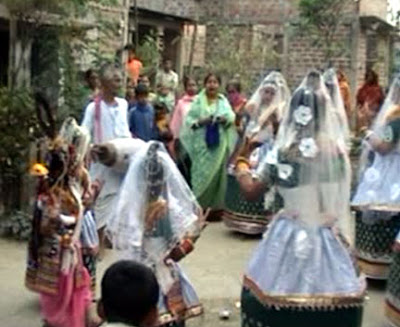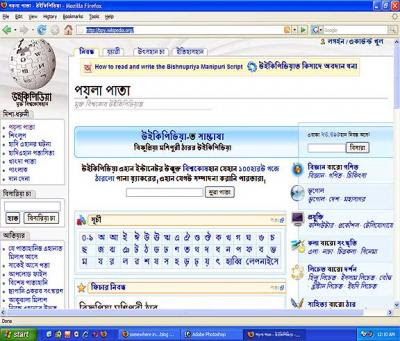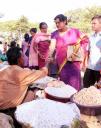Bishnupriya Manipuris are, a constituent of the conglomeration of diverse ethnic groups in the Barak Valley. Officially, they are a linguistic minority. There are as many as 146 villages in the valley and population in rural areas was 66,623 in 1967. Curiously enough, figures published in 1961 census were totally incorrect. Social workers undertook, in protest, to conduct census, which revealed, tidy certified by t-he respective Village panchyats, the actual above - mentioned figures. Coming to the closing decade of the century the figure would be around one and half lakhs. Indeed this community has suffered diminution at every stage of its historical evolution.A quick look at its remote and recent past will hope , not be out of place here.
The Bishnupriya Manipuris, belonging as they do to the Indo-Aryan group of Manipuris, have a great antiquity. Manipur was known to the Burmese as Kathe as it belonged to the Kshatriyas coming from the Western and Northern India and to the people of Assam as Moglu. It was also known in the Epic age as Makhalee which the people of Southern China would call Meiun Khala meaning the country of the wide lake (Logtak) and the inhabitants were called Maiyangs or Khalachais,who claim their descent from Babrubahan, a son of the valiant Arjun of the Mahabharata fame, and adoption of the cult of Lord Bishnu. Hence they were called Bishnupriyas and had their ancient capital town at Bishnupur which the 7th century Chinese pilgrim Hsuan Tsang had mentioned in his account as Ishangnupul. Unfortunately , though reputed to be the first cultured ruling race of Manipur they had to bear the brunt of a series of Kuki-Chin incursions and the valley, ultimately went, under the occupation of the Melteis.
E.T.Dalton says : "By degrees the Meiteis became dominant and that name was applied to the entire colony. It is highly probable that these hordes oven-an a country that had been previously occupied by people of Aryan blood known in Western India and to the bards.Me present population of Manipur includes a tribe called Meiun who speak a language of Sanskrit derivation They are now in a servile condition performing the duties of grass-cutters to their conquerors".
The oppressions acted upon the Bishnupriyas followed by insensate burning of books and records during the reign of king Pamheiba in the early part of the 18th century, resulted in the annihilation of the old tradition. Repeated Burmese invasions that followed such tyrannical rule caused a large number of Bishnupriyas to leave their heart and home, migrate partly to Cachar, Sylhet and Tripura and partly to Burma. Of the remaining population a major portion merged with Meiteis and only a fraction was left to see its rapidly falling moral and material standards and find its mother tongue forced helplessly into oblivion. The burning of books, searched out even from hidden comers , however, continued to avert any possibility to trace the history of Manipur and Chronicles were prepared under the strict supervision of the Icings. W.Shaw and Raj Mohan Nath , two eminent scholars are of the view that " Bishnupriya " with its Devanagai script had been the court language of Manipur and was replaced by king Khagenba . The Meiung or the Bishnupriya Manipuri language is virtually extinct in present Manipur though 1000 speakers of this language could be traced there by Dr. Grierson early this century during his linguistic survey.
Ravages of history , however , have not been able to demoralize the people altogether. They have somehow sustained themselves with their devout nature and innate cultural traits . This Will be evident from the observations of late Mr. C.S.Mullan , I.C.S. - "The Manipuris of Cachar and Sylhet are really people apart... they are foreigners in a strange land and have kept very much to themselves preserving their own language . They must , in my opinion , be considered as a community requiring special treatment rather than a backward race".
The foreword by late A.K.Chanda , Bar-at-Law , one of the architects of the Barak- Valley. , to a memorial on the occasion of the eighth general session, of Nikhil Bishnupnriy Manipuri Mahasabha held at Bhakatpur near Silchar on 26th -and 27th December 1938 , is still more illuminating . As the chief guest of the session he addressed the Chief Minister, Assam, in memorable words -
"In forwarding the memorial to you for the sympathetic consideration of your govt. I desire to reinforce it by adding my humble voice in its support . As one between whose family and Manipuris have subsisted ties of friendship for three generations now, I feel it would not be presumptuous on my part but rather duty to submit that the memorialize have made out a strong case for special recognition of the claims of Manipuris. I endorse every word of the remarks made by Mr. C.S.Mullan, I.C.S. as quoted in the memorial . Manipuris have a culture of their own ; although settled among us , they have yet preserved their entity as inviolate . But this insular ism has caused them hard in that day they have been very reluctant to respond to the calls of time . Once high in annals of bravery and various kinds of arts in peace they find themselves relegated to the background for lack of modem education and also initiative. While other. communities are forging ahead , they are content to eke out a precarious existence steeped in illiteracy, ignorance and want . They are suffering from lack of initiative as they are without a leader strong enough to rouse them from their stupor.. It now behooves your govt. to extend them a special measure of protection without which the future of such a fine race seems doomed."
The historical role played at this juncture by the Surma Valley Manipuri Association , known as-the Nikhil Bishnupriya Manipuri Mahasabha later in 1932, cannot be over - emphasized . This is the foremost socio cultural organization of the society, established in June, 1 932, and has been working steadily for the betterment of the community. It may be noted here that in the census of 1931 Manipuris were classified as tribal people belonging to the Tibeto -Burman stock . The census commissioner Dr.J.H.Hutton , however, reclassified them under the caste Hindu Indo-Aryan group in 1933 on a thorough scrutiny of historical records received from the Bishnupriya Manipuris of Cachar under the aegis of Surma Valley Manipuri Association .
Foremost among the earlier poets is of course Gitiswami Gokulananda who traversed the whole of Bishnupriya-speaking region - singing with a missionary fervor of the ills of our society and their remedies His performance was mostly dramatic, the follies and foibles of our people were their by held up to ridicule. He denounced especially the vice of imitation It may be mentioned here that his role is comparable-.to that of Mukundadas in Bengal who flourished during the glorious years of national resurgence and stirred the hearts of millions with his powerful songs Though his sphere of activity was limited in sense , he must have come under the turbulence of the times and he appeared to have wider sympathies.
A quick look at our recent past will reveal the circumstances which were responsible for the making of this great reformer -poet. Laboring under a depressed economy our women belonging to the lower middle class went to the market to sell certain daily necessities This was not considered dishonorable till it was found that indignities were often hurled at. these innocent women by some vulgar people at the marketplace While a young man Gokulananda was shocked to find a women thus victimized -but none came to her help The incident filled him with pity and indignation and., led him on to a tragic realization of our predicament And he took the momentous decision of devoting himself to the cause of his community: to improve the condition of our people and to keep pace with the progress of other communities .. He dramatized the plight of our women against the comparative indolence of our men at the time . His songs were simple and direct , often did active in tone as he had a serious purpose in mind. His personality was eminently suited for the purpose -a very compassionate face with luminous eyes; his mouth slightly curved to the left which gave him the impression of a man of determination .His measure of success can be guessed from the endearing title "Gitiswami" bestowed on him He was indeed the master of lyricism in our language; his song immortalizing Mother Bishnupriya shows him as a man at the height of attachment to his community. What is more, he did much for the awakening of our social conscience through his dramatic performances and other works.
The impact of this great wandering singer on the Bisnupriya Manipuris has been manifold. We are, aware of the fact by now that we need real poets not mere versifiers poets at the altar of humanity. Gitiswami has been one of the major sources of inspiration from whom our present-day poets, and social workers for that matter, continue to draw their sustenance. Instead of just being blank onlookers , we are now more inclined to look within ourselves without illusion and any false sense of' self satisfaction . We are thus redeemed by the promptings of a loving heart which taught us to love our good things - our culture, our devout acceptance of life . He has proved himself to be our never-failing friend, philosopher and guide.
Bishnupriya Manipuris , as already pointed out, are of a devout nature belonging to the Gaudiya Vaishnava sect . Sri Bhubaneshwar Sadhu Thakur bom at Baropoa (now renamed Bhubaneshwar Nagar) in Cachar has, so to say saved the people from spiritual degeneration owing to abject poverty. They have learnt from him to live honestly. and peaceably with what little they have. No wonder they look upon him as their saviour . The temple of Sri Govinda, popularly known as "Govindabari " at Nabadwip in West Bengal is a veritable abode of peace for the devotees.
Next , the name of the noted dramatist Leikhomsena Sinha from Singari near Silchar , late lamented father of Guru Bipin Sinha the ereat exponent of Manipuri dance, also deserves mention ..Besides , a host of other poets and socially conscious person have contributed their mite for the advancement of the community.
Despite their depressed economy , the position of the Bishnupriya Manipuris in the fields of education , science and culture in this valley is considerably good . Late Mahitosh Purkayastha , ex-MP, and a much respected leader of South Assam noted more than a decade ago : "as regards the sociocultural identity , the 40000 Bishnupriya Manipuris constituting less than 0.30% of state population do not consider themselves lost socially and culturally although they have socio-political evinces of deprivation." The case in point gets clear from the 13th Report of the Commissioner for Linguistic Minorities of India (July, 1970 -June , 1 971 Article 15, page 1 8)
"As a result of non-implementation of the constitutional provision of Artici.-I 3 50A by some states, specific demands of some linguistic minority groups to have instructions through their mother tongue at the primary stage, have not been conceded Prominent among such pending issues -are the cases of the-speakers of Bishnupriya Manipuri in Assam,,speakers of Saurastri in Tamil Nadu Santhali in West Bengal.."
This leads us on to the crux of the question 'Are Bisnupriyas Manipuris at all' ? Of course they are. That is why they have consistently refused offers of both the state and central Goverments to accept as Bisnupriya only They have voiced their constitutional demands through peaceful, democratic movements over the years. But unfortunately things have gone wrong The right- minded persons of the valley with a keen historical sense can I hope certainly solve this tangle The cultural identity of the Bisnupriya Manipuris would be at stake if the term "manipuri" is dropped or deleted "Culture", as renowned Prof. E.Ninkanta Singh from Manipur says , "reflects the soul of a people . And to understand a people's culture , one has to flow along with the current of heritage. The origin of the Manipuris ( or properly speaking, the Meiteis ) is still a mystery . But modem researches have pointed unwavering finger to the East from where migratory waves have reached this land thousands of years ago".
Rabindranath Tagore , with his poetic vision of beauty, was attracted to Manipuri dance on a visit to Sylhet early this century and decided to introduce this beautiful classical dance at Santiniketan recruiting teachers from both Bishnupriya and Meitei communities, Thus began the onward march of this unique culture . What is more, religion and culture are almost inseparably interwoven in this form and the artists of all age-groups perform it in a subdued manner peculiar to this. form . The Ras Leela , for example, on a moonlit night is a wonderful spiritual experience for the admirer. Towards the close of the performance , at the early hours of dawn , the rhythmic companions of Radha do not want to leave the " Kunja " , the bower meant for divine dalliance The whole atmosphere is- charged with emotion. as it were , and the performers , though traditionally dressed, appear to be "appareled in celestial light
In the final analysis , the present analyst , for want of an adequate critical apparatus , would like to have recourse to a simple botanical analogy. If the Bishnupriya ,Manipuris are divested of 'the authentic cultural identity of "Manipuri" a blossom of Manipuri culture will be detached or nipped from the stalk . Let it not wither away in desert air.
References:
1. The Mahasabha Review, 1970
2. Memorendum to Dr. Pratap Chandra, Ex. Education Minister, Govt. of India,1977.
3. Let history and facts speak Manipuris - Nikhil Bishnupn'ya Manipuri Sahitya Parishad, 1984.
4. Anatomy of North-East, Purkayastha M. 1980.
5. Souvenir, East India Cultural Conference 1975.
6. Ethnic Processes in North-eastern India - Acharjee, S.K. Special article in "Economic and Political weekly", May 21, 1986.
Cotributed by: Barun Kumar Sinha






















































